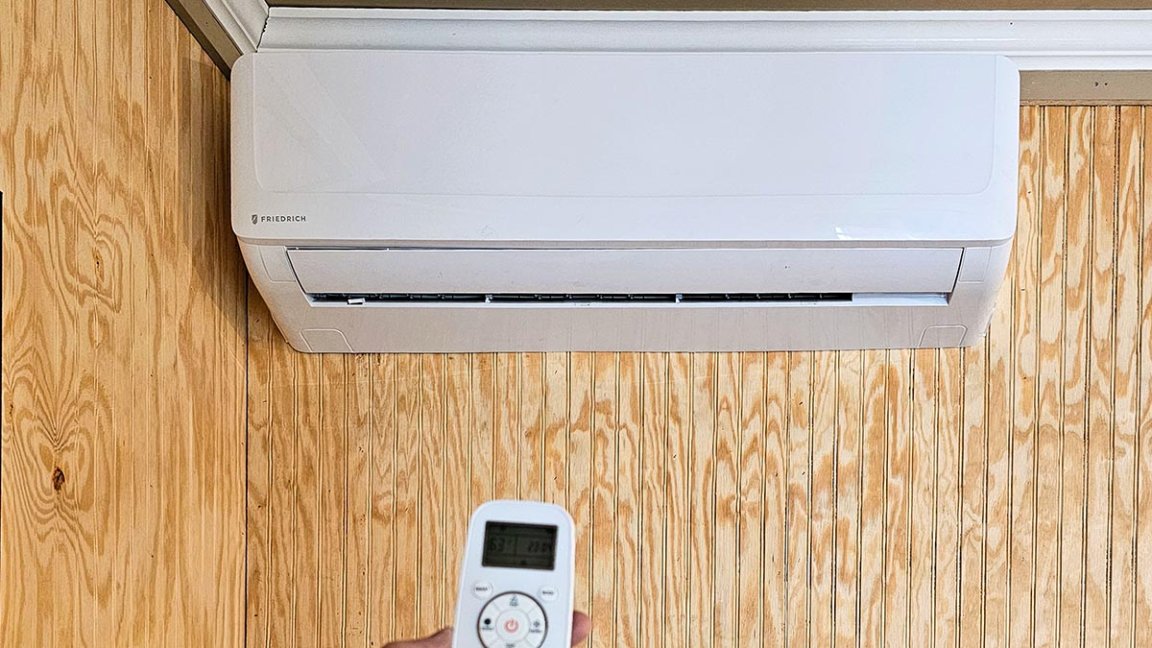We may earn revenue from the products available on this page and participate in affiliate programs. Learn More ›
Friedrich FPHW183B Mini-Split: At a Glance
Rating: 4.8/5
Mini-split heat pumps are gaining in popularity for a couple of reasons. They offer heating and air conditioning in a single unit, and installation is often much simpler compared to a traditional HVAC system. They’re perfect for single rooms, workshops, or garages, and they’re quieter than window or over-the-sill AC units. We installed an Energy Star-certified heat pump mini-split from Friedrich on a small commercial building and tested all its features.
This is the first mini-split we’ve tested, and we really didn’t know what to expect. Keep reading to learn more about this trending technology and to find out how the Friedrich mini-split performed in our hands-on tests.
| What We Like | What We Don’t Like |
| Energy-efficient with a 21.0 Seasonal Energy Efficiency Rating 2 (SEER2) | Professional installation required |
| Super-quiet operation | |
| Quickly heats and cools spaces FastPro technology simplifies installation |
| Friedrich Heat Pump Mini Split Specs | |
| British thermal units (BTUs) | 18,000 |
| Efficiency ratio | 21.0 SEER2 |
| Heat pump | Yes |
| Refrigerant | R454B |
| Energy Star certified | Yes |
Testing the Friedrich Mini-Split Heat Pump
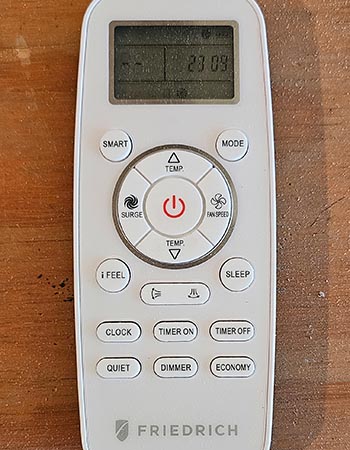
The first step in installing the Friedrich air conditioner/heater combo was selecting a suitably sized unit. Like HVAC systems, mini-splits are sized according to the size of the space they’ll be heating and cooling. The building where we chose to install and test the Friedrich has a relatively small main area of about 630 square feet with a 9-foot ceiling corresponding to the Friedrich FPHW183B 18,000 BTU single zone unit. This bundled unit contains the FAHFW18A3A wall unit and the FPHSR18A3B outdoor compressor.
We installed the exterior compressor on the building’s roof and the floating wall unit at the upper edge of the interior wall. We hired an HVAC company to run the refrigerant lines, as required by building code. After installation, we tested the mini-split to see how well it heated and cooled the space. It comes with a remote control and the ability to download an app and sync the unit to a smart device.
Energy Efficiency and SEER2 Performance
The Friedrich ductless mini-split is Energy Star certified, meaning it meets the Environmental Protection Agency’s energy-efficiency guidelines. The unit is rated 21.0 on the SEER2 scale, which is an updated version of the earlier SEER, which measures how efficiently an air conditioner or heat pump operates. A rating of 21.0 easily surpasses SEER2 guidelines for all regions in the United States.
But how well did the Friedrich heat and cool for us? It performed very well, although it was much easier to test its cooling than its heating ability. The unit was installed on a summer day when the outdoor temperature neared the century mark. By the time the mini-split air conditioner was up and running, it was midafternoon, and everyone in the building was sweating. Within 15 minutes of starting the Friedrich, we could all feel a slight drop in temperature. At one hour, the temperature had dropped to a comfortable 70 degrees Fahrenheit.
Testing the unit’s heating capability was more challenging because it was hard to know how much heat the Friedrich was putting out and how much was being absorbed through the exterior walls of the building. To reduce the ambient heat effect, we opted to test the unit’s heating ability early one morning before it got light. First, we ran the unit’s AC to bring the room’s temperature down to 60 degrees Fahrenheit. Then we turned up the temperature. In 35 minutes, we were at 75 degrees Fahrenheit in the building. We have to attribute part of that to the outside temperature, which was 80 degrees Fahrenheit when we tested. Still, the mini-split put out a good amount of heat.

Installation Aspects
Certain aspects of installing the Friedrich heat pump mini-split AC are DIY-friendly, but others require the services of professionals. We were able to set the exterior unit on the building’s roof, cut a hole in the wall for the piping, and mount the interior bracket plate that supports the floating air handler. What we couldn’t do was connect the refrigerant lines and some of the wiring.
Fortunately, Friedrich uses FastPro Technology to reduce the amount of time and work an installer has to spend on the unit. We hired a couple of very knowledgeable and professional technicians from McPherson Quality Air, and they had no problem hooking up the Friedrich mini-split, although neither was familiar with the Friedrich brand.
We did run into one installation issue when we were trying to find an HVAC company to install the Friedrich. Several companies told us that if they didn’t sell the unit themselves, they wouldn’t install it. If you’re looking to install any mini-split, it might be worth calling local HVAC companies ahead of time to see which ones they are comfortable installing.
All in all, it took us about 3 hours to accomplish our part and about 3 additional hours for the technicians to complete their part. Keep in mind that they had to climb up and down from the roof; had we mounted the compressor closer to the ground, it would likely have taken less time.
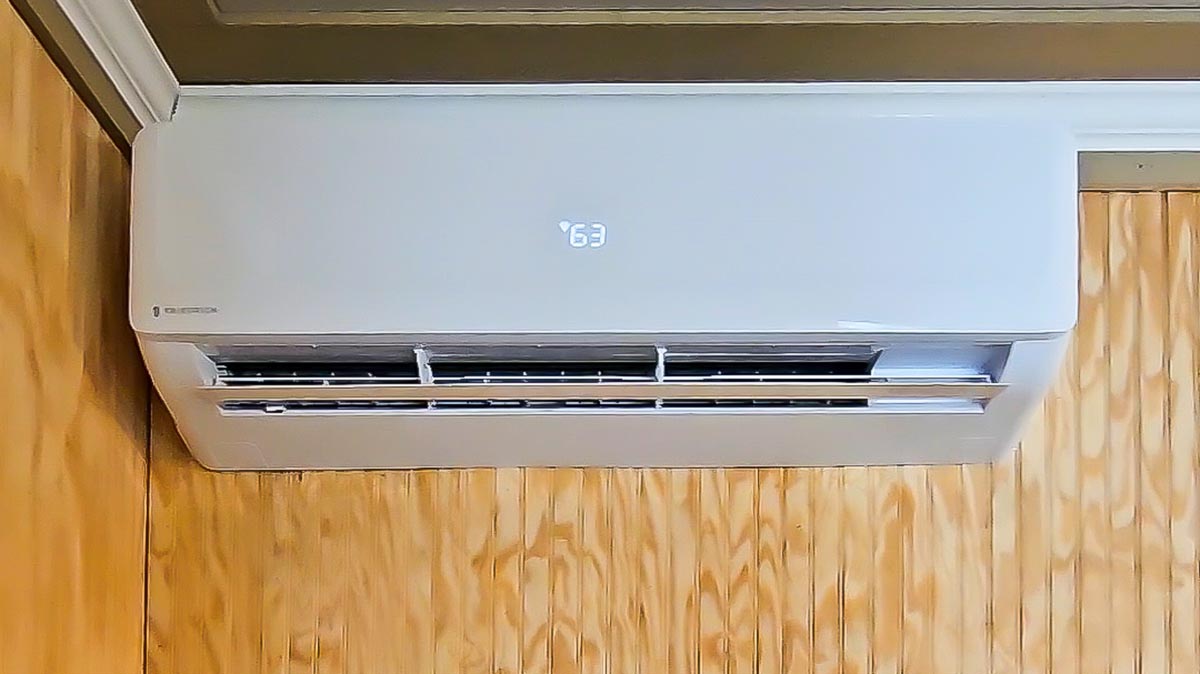
Operating the Friedrich Heat Pump Mini-Split
Just as with any new appliance, there’s a learning curve when it comes to operating the Friedrich mini-split, but for the most part, it’s intuitive. Within 15 minutes of studying the remote control and comparing the buttons with the directions in the instruction manual, we’d set the clock, scrolled through all the power modes, tried out both the vertical and horizontal louver-swinging ability to evenly distribute cool air in the space, and programmed the timer.
But, there’s more to it than that. The Mode button allowed us to select between Cooling, Dry, Fan Only, or Heat. For anyone living in a humid climate, Dry mode will help you feel more comfortable whether or not you’re cooling simultaneously. In this sense, the mini-split is similar to a dehumidifier, and it’s rated to remove up to 2.7 pints of moisture per hour from the air. That’s a nice perk.
The fan has six speeds, and all of them are super quiet. The strongest speed is called Surge, and it makes quick work of cooling or heating a space but only creates 48 decibels of sound. That’s comparable to the sound of a dishwasher running in the background. At the lowest speed, we had to stand right under the air handler to be able to hear it. Yes, it’s really that quiet. If you’ve ever had to be in the same room with a window AC unit, you won’t believe how much quieter the Friedrich mini-split is.
For convenience, the remote also has a Smart button. At first, we thought this was about syncing it with Wi-Fi, but we were wrong. The Smart button allows the unit to cool, heat, and dehumidify based on the temperature in the room. If the temp in the room is below 70 degrees Fahrenheit, the unit heats. If the temperature goes over 79 degrees Fahrenheit, it starts cooling the air. Only the fan runs between 70 and 73 degrees Fahrenheit, and the mini-split dehumidifies between 73 and 79 degrees Fahrenheit.
The only feature we didn’t get to test was the Wi-Fi connection because there is no wireless network in the building where we installed the Friedrich. But, if it works even half as well as the unit’s other features, it will be a slam dunk too.
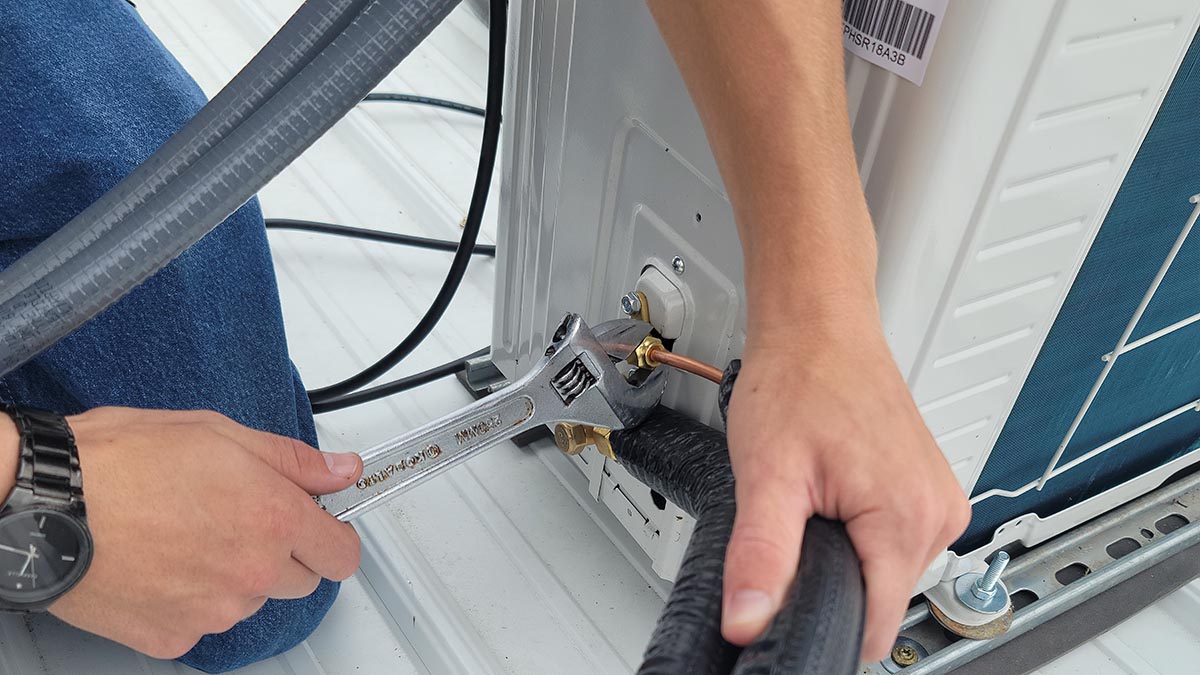
Why The Friedrich Ductless Heat Pump is Worth the Investment
You can buy a less expensive 18,000 BTU single-zone mini-split, but we doubt you’d find one that’s as easy to install and that performs as efficiently as the Friedrich. Currently, the bundled unit sells for $1,899 from ToolHomeSupply, but it will likely start appearing on other retail sites soon.
The Friedrich FPHW183B is Energy Star certified and boasts a high-efficiency 21.0 SEER2 rating. Its ductless heat pump technology saves money over other ways of heating and cooling, and the exterior compressor unit can be installed along a wall, on the ground, or on the roof as we did.
The Friedrich Air Conditioning Co. was founded in 1883 and has long been known for its high-quality products. Friedrich environment products are designed for residential and commercial use, and in our hands-on test, this unit was efficient and unbelievably quiet.
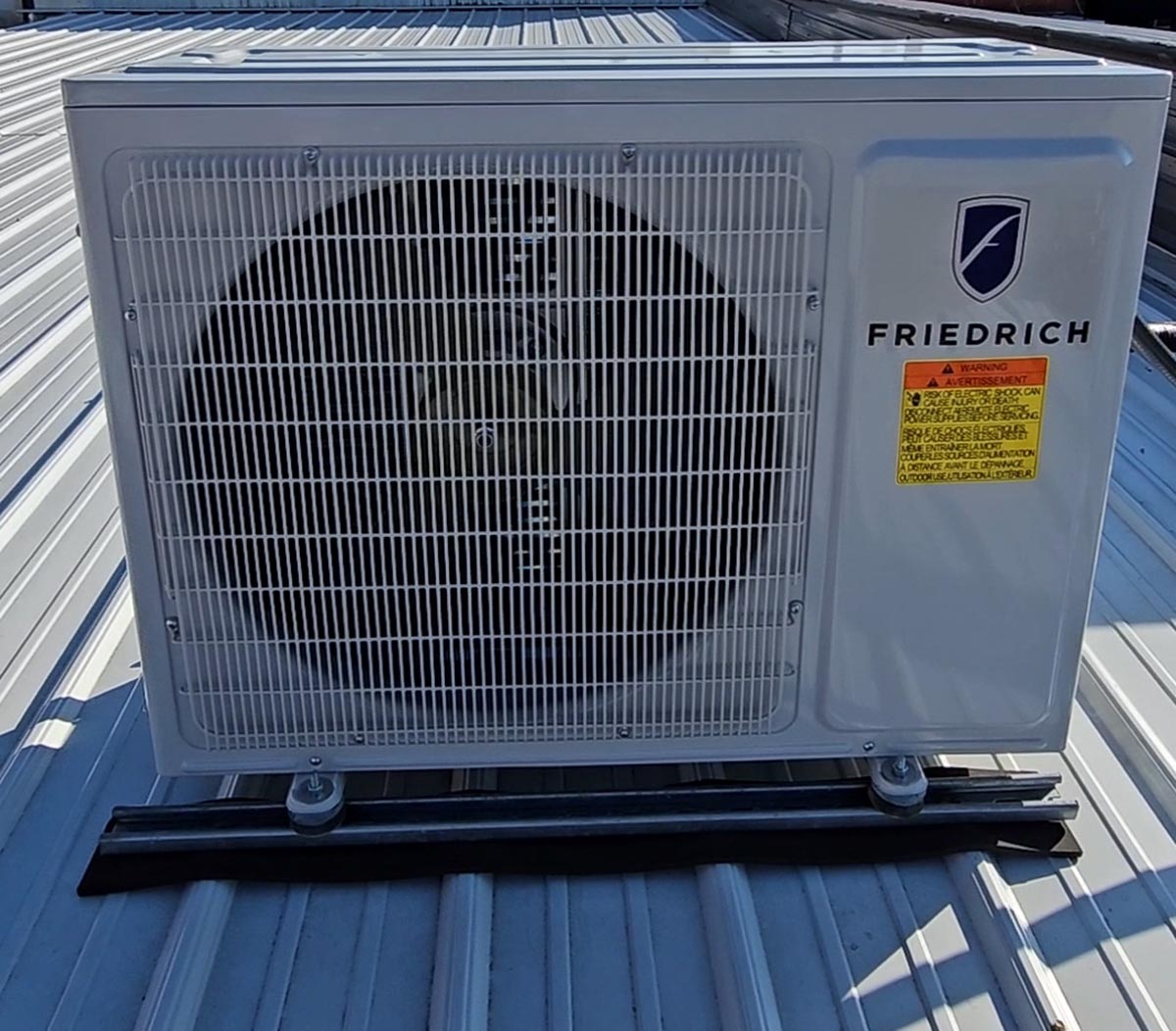
Product Comparisons
| Friedrich | Pioneer | MrCool | Denali Aire | |
| BTU | 18,000 | 18,000 | 18,000 | 18,000 |
| EfficiencyRatio | 21 SEER2 | 19 SEER2 | 22 SEER | 23.3 SEER |
| Wi-Fi | Yes | Yes | Yes | Yes |
| Energy Star | Yes | No | Yes | Yes |
| Cost | $1,899 | $1,088 | $2,165 | $1,499 |
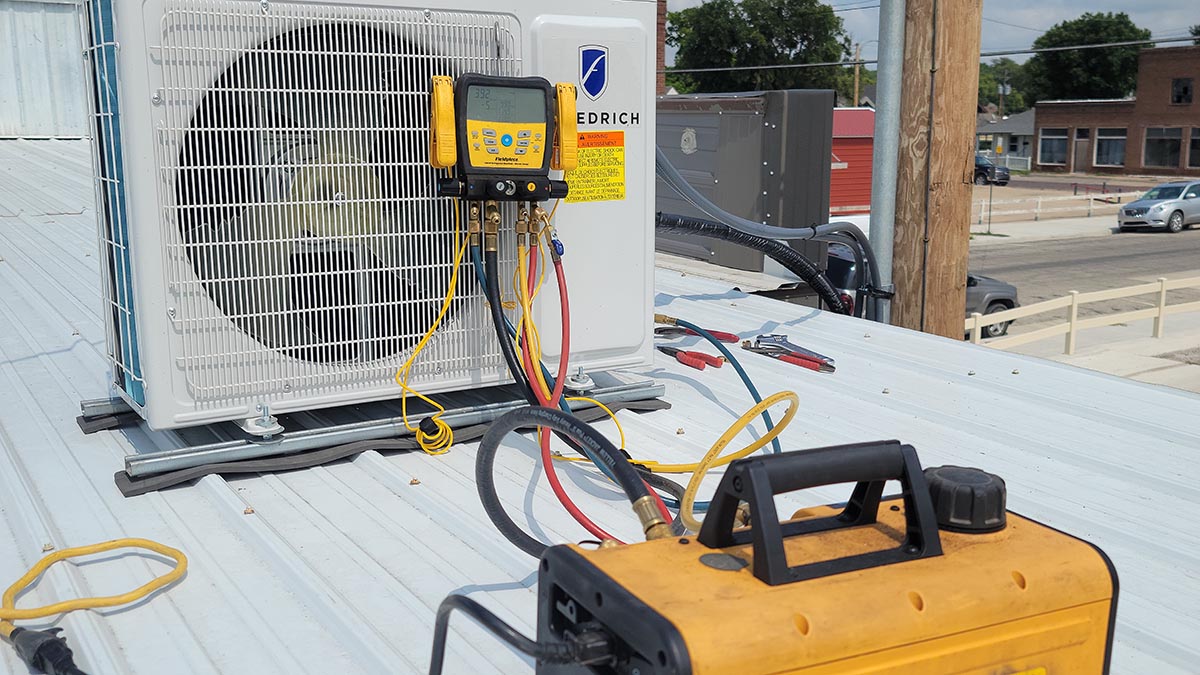
So, is the Friedrich ductless mini-split right for you?
If you’re considering installing a mini-split system, and you value efficiency, ease of installation, and quiet operation, this Friedrich bundle might be just what you’re looking for. It’s designed to heat and cool spaces up to about 800 square feet, and it comes with a 21.0 SEER2 energy rating, which could mean lower heating and cooling costs.
Its FastPro installation technology means the HVAC techs can hook it up more quickly, so you may save some money on installation costs. Plus, if you’re handy, some of the preliminary setup is DIY-friendly. The interior air handler unit sits high on the wall and takes up very little space, making this a good alternative to using a portable AC unit.
However, if you’re only planning to use the unit as a backup to an existing HVAC system and you won’t run it consistently, purchasing a cheaper model might make sense. The Friedrich ductless mini-split heat pump was the perfect choice for our building. It offers high-efficiency energy savings and is so quiet we typically don’t even know when it’s running.
Meet the Tester(s)
Glenda Taylor is a product tester and writer specializing in the construction, remodeling, and real estate industries. She and her husband own a general contracting company, and Taylor is experienced in both residential and commercial building applications. She tests a wide range of power tools as well as other home improvement, household, and lawn-and-garden products.
